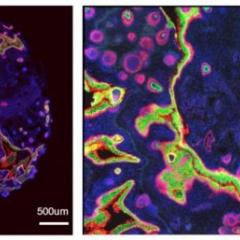A new method of genetic analysis developed by researchers based at the Queensland Brain Institute (QBI), The University of Queensland Diamantina Institute (UQDI) and the Queensland Institute of Medical Research (QIMR), has shed fresh light on the elusive genetic underpinnings of schizophrenia.
While previous studies have pinpointed several genes along with rare chromosomal deletions and duplications associated with the disease, these account for less than three per cent of risk of schizophrenia.
But the new method found that about a quarter of schizophrenia is captured by many variants that are common in the general population.
According to QBI’s Associate Professor Naomi Wray, who led the international study, this suggests that we all carry genetic risk variants for schizophrenia, but that the disease only emerges when the burden of variants, in combination with environmental factors, reaches a certain tipping point.
“They imply that each affected person may carry a unique combination of genetic risk variants, which in turn is consistent with a spectrum of symptoms and treatment responses,” says Associate Professor Wray.
Published in the latest issue of Nature Genetics, the study uses very distant genetic relationships between individuals that are estimated from nearly a million DNA markers, and shows the extent to which people with schizophrenia have more similar genomic profiles to each other than to people unaffected by this disorder.
This is the largest study of its kind to date with more than 20,000 participants.
Associate Professor Wray says the results hold out hope that as even larger study samples are collected, more specific genes will emerge, which will provide clearer insights into the underlying biology of schizophrenia.
It’s a paradigm which has already proved to be successful for other complex genetic traits and disorders, such as Crohn’s Disease.
Associate Professor Wray says that better understanding the genetic architecture of schizophrenia will ultimately aid the earlier diagnosis and management of the disorder.
“Because the risk of any one gene is so low, order to make further progress we need to gather even larger cohorts that are carefully collected with detailed symptom and treatment information,” she says.
Associate Professor Wray is one of 96 co-signatories of a letter published this year in Molecular Psychiatry, the premier journal for research in psychiatry, calling for investment in larger cohorts for genetic studies of psychiatric disorders.
“Larger cohorts will allow us to identify biological pathways contributing to risk of schizophrenia and to identify patterns in genomic profiles in different groups of affected people, which is the key to personalizing treatments,” she says.
Schizophrenia is a common, chronic and often devastating brain disorder characterized by persistent delusions and hallucinations.
It affects about 1 person in 100 at some point in their lives and usually strikes in late adolescence or early adulthood.
Despite the availability of effective treatments, the course of the illness is usually chronic, and response to treatments is often limited, leading to prolonged disability and personal suffering.
Family history, which signifies genetic inheritance, is a strong risk factor for schizophrenia.
by Denise Cullen I QBI
FOR FURTHER INFORMATION CONTACT
Naomi Wray
Associate Professor, QBI
Email: naomi.wray@uq.edu.au
Helen Weir
Institute Manager, QBI
Phone: +61 7 3346 6404
Email: h.weir@uq.edu.au
NOTES TO THE EDITOR:
Statistical Psychiatric Genetics Laboratory
The primary research goal of Associate Professor Naomi Wray’s laboratory is to understand the genetic contribution to complex genetic disorders. Her research focuses on development and application of novel methods for analysis of genetic data with applications primarily in psychiatric disorders.
Queensland Brain Institute
The Queensland Brain Institute (QBI) was established as a research institute of the University of Queensland in 2003. The Institute is now operating out of a new $63 million state-of-the-art facility and houses 33 principal investigators with strong international reputations. QBI is one of the largest neuroscience institutes in the world dedicated to understanding the mechanisms underlying brain function.
What is GWAS?
GWAS is the abbreviation for genome-wide association studies. Since 2005, GWAS have successfully identified thousands of genes responsible for common human diseases, They were conceived to examine if genetic variants that are common in the population contribute to the risk of disease. It is widely recognized that these studies have brought about an unprecedented flood of biological discoveries across a broad range of common human diseases. However, GWAS have identified only a small number of all the genes involved in common diseases, including schizophrenia.
The process involved in GWAS involves rapidly screening hundreds of thousands of DNA markers (single nucleotide polymorphisms, or SNPs) of known location on the human genome across thousands of DNA samples of people with a particular disease and thousands of healthy people (controls).
What is a SNP?
SNPs are single nucleotide polymorphisms that are relatively evenly spaced across the human genome (approximately one every 80 bases) and are strategically selected to comprise a dense panel of markers of genetic variation for use in GWAS. If certain SNPs are associated with disease – that is, if they are significantly more frequent in disease cases than controls, they highlight a region of the genome where disease-causing variants may be located.



